Review for Shikabane Hime: Corpse Princess - Part 1 (2 Discs)
Introduction
It was back in autumn of 2008 that I first encountered Shikabane Hime, one of the earliest anime shows to receive an online simulcast in parallel with the Japanese television broadcasts, this time courtesy of Funimation. At the time, I watched it religiously, and not only for the novelty of having anime online, free and legal, but also because it was a peach of an action show, brilliantly animated and very enjoyable. At the time, with its combination of action and fan service, blood and guts, and supernatural antics, I opined that it was a show that was right up Manga Entertainment's alley. It's taken two and a half years, but here it finally is, on DVD courtesy of Manga Entertainment. Of course that delay is down to Funimation having to licence it for US DVD release, and to create an English dub, as well as find the requisite spot in their schedule to release it, which finally happened last year. It also has to do with waiting for someone in Australia, in this case Madman Entertainment to licence it, and create a PAL master. It actually makes 2 and half years seem like not a lot of time at all when you think about it. And by waiting that long, it means that Shikabane Hime gets its UK release at a very propitious moment, when the fan appreciation of zombies and the undead is at a fever pitch, with movies and TV series regaling our entertainment media. Zombies are cool, and Shikabane Hime is the perfect accompaniment to High School of the Dead, which Manga are releasing later this year.
What appeals at first about Shikabane Hime is that it's a Studio Gainax production, those wizards behind Evangelion, FLCL, and Gurren Lagann; renowned for the scope of their visual imagination, and the level of detail and quality that is typical of their animation. Just thinking about the combination of Gainax and zombies is enough to get the mouth watering. Shikabane Hime was originally released as two series, Shikabane Hime Aka, and Shikabane Hime Kuro, Red and Black, but for the US release, Funimation opted for the literal translation of Shikabane Hime to the less than elegant Corpse Princess and released it in two 2-disc sets. That's how Manga Entertainment are doing it too, but they at least have compromised on the title, in the UK it will be released as Shikabane Hime: Corpse Princess.
If someone dies with strong, overpowering regrets and obsessions, then that death isn't permanent, and that corpse rises as a Shikabane, fuelled purely by hatred, and preying on humans. The Kougon sect exists to combat this, but the only thing that can destroy a Shikabane is another Shikabane. So it is that the monks of the Kougon sect seek out young girls who die before their time, overwhelmed by regret. Before they can turn into monsters, the monks form contracts with them, enabling them to maintain some semblance of humanity, in exchange for the newly formed Shikabane Hime to fight and destroy Shikabane. The upside of the contract is that if the Shikabane Hime manage to destroy 108 Shikabane, then their passage to heaven, a peaceful death will be assured.
Ouri Kagami wasn't meant to know about any of this, even though a Kougon monk named Keisei Tagami adopted him. Keisei tried his hardest to keep his duties as a monk separate to the orphanage he runs where Ouri was brought up. But from the first moment that Ouri came to live there, he's had an unnatural fascination with death, has been able to sense the supernatural. Indeed it was the spectre of a cat that only he could see that led him to the temple one night, where he saw his brother Keisei bring the corpse of a young girl back to life. Ever since then, Keisei would often come home bruised and bloodied, and making excuses for his dishevelled state.
Now, two years later, when Ouri has started high school, and is moving out to become more independent, he collides head first with the world of the Shikabane Hime and the Kougon sect. A dead girl falls from the sky, practically into Ouri's lap. She's the same girl from that night in the temple, her name is Makina Hoshimura, she's a Shikabane Hime, and contracted to Ouri's brother, it's her job to find and kill the monsters known as Shikabane. Keisei tries to keep his involvement secret, but Ouri keeps showing up wherever Makina is hunting Shikabane. The Kougon organisation gets more and more suspicious of Ouri because of this, and it's the worst possible time for the return of a renegade monk named Akasha, putting into action a twisted plan to rid the world of the Shikabane Hime and the Kougon monks. On top of that, the Seven Stars reappear, an organisation of Shikabane whose plans are far more long reaching and insidious than the general bloodlust that drives other Shikabane. The Seven Stars were the monsters that murdered Makina Hoshimura and her family, and the sole reason that Makina became a Shikabane Hime, contracted with Keisei, was never to get into heaven. She wants to find the Seven Stars and kill them all.
This first collection contains the thirteen episodes of Shikabane Hime Aka on two discs.
Disc 1
1. The Dead Dance
2. The Game Continues
3. Voice of Night
4. Hymn of Tragedy
5. Traitor Monk
6. At the End of the Dangerous Run
7. The False Power of Words
Disc 2
8. Serenity
9. Set Your Heart Aflutter
10. Stars on the Ground
11. One Night
12. Dawn
13. Funeral Program for a Contracted Monk
Picture
Shikabane Hime gets a 1.78:1 anamorphic transfer. It's a native PAL transfer courtesy of Madman in Australia, one that does the animation full justice in bringing out the complexity and indeed the beauty of some of the scenes. Studio Gainax are a little predictable with the character designs, simple but memorable, and typical of most anime. They also wheel out the full fan service when it comes to the various Shikabane Hime, knowing full well what the audience for this show is likely to be. But Shikabane Hime is a moody and dark tale, and that is reflected in the style of the animation, with some seriously atmospheric and edgy scenes. The animation is top notch, fluid and vibrant, with the action sequences for once living up to the effort put into the opening sequence used to sell the show. The image is clear and sharp throughout, compression artefacts are kept to a minimum, and any grain applied to the image is simply a matter of creative choice. Shikabane Hime is a seriously fine looking series.
Sound
You have the choice between DD 5.1 English and DD 2.0 Japanese, along with optional translated subtitles and a signs only track. I always opt for the original language track, but this time I had thrice the reason to do so, as this series offers a Yui Horie overload, she plays three roles in the show. That said, Shikabane Hime is one of the few shows that I would be happy watching in either language. From what I sampled of the dub, about an episode's worth, the English audio track holds up very well against the Japanese dub, and given that Shikabane Hime is a jargon heavy show, it's even better if an excess of subtitling can distract you. Besides, the 5.1 remix is an exceptionally decent one for an anime show, doing much more than just simply throwing the music and sound effects to the rears. There's some nice, atmospheric placement of effects that really bring across the supernatural elements of the show, and highlights the many action sequences. Shikabane Hime also gets some rousing theme songs from the Japanese group Angela, which for once aren't at odds with the tone of the story.
Extras
The discs present their content with static menus, and jacket pictures for those with capable players.
The extra features are all on the second disc, the most substantial being the episode 12 commentary, which sees ADR director Terri Doty, voice of Ouri, Aaron Dismuke, and voice of Makina, Luci Christian chat about the show, the cast, the recording process, and have a lot of fun watching the episode.
You also get the textless opening song, and two of the textless closings. For those of you who want to hear what difference a 4% PAL speedup makes to the pitch of the audio, listen to one of the textless credit sequences, which are presented as NTSC-PAL conversions, and then listen to the same sequence in an episode on the disc. It makes a fair bit of difference. I only notice it when I hear the two side by side though.
Conclusion
The first thing that you ought to know, is that Gainax made this show for the discerning anime fan first and foremost. You'll almost be overwhelmed by the clichés and tropes that assail you at first. It's a show laden with fan service, the set up of a priest and a contracted Shikabane Hime pretty much ensures that each monk will have a certain female anime cliché fulfilled by his contracted warrior. Makina is classic tsundere, hard and abrasive on the outside, but soft and caring inside. Minai is the vulnerable needy type, Itsuki is cheeky and playful, Saki is mischievous and bratty, and Akira is cynical and quietly abusive. Then the character designers get to work, ensuring plenty of curvaceous heroines, augmented breast sizes, ample booties, and costumes that enhance those attributes, school uniforms with short skirts, and the implication of an absence of underwear. The animators make the most of this by supplying copious amounts of fan service, but never enough to distract from the story. On the other hand, Shikabane Hime is one of those shows that tries to lock in its fan base by introducing loads of jargon, providing over the top amounts of detail about the world of the Kougon monks, the Shikabane, the Seven Stars, certainly more information than the story requires. It also suffers from character overload, it's hard to keep track of all those monks and their Shikabane Hime, especially all the similar looking bald monks, you certainly won't get to know all of the Seven Stars in this volume, and if like me you feel the need to refer to Wikipedia on occasion to keep all this straight, it oughtn't be a matter of shame.
So far I've described a typical shonen show revolving around the afterlife, a Bleach or a Shakugan no Shana. That's a fair amount of reason not to buy the show. But this is just the beginning of Shikabane Hime, not the end. The tropes and the clichés, the fan service and the jargon all exist to sate the expectations of the jaded anime fan, who know what they want from their anime, and would boycott anything less. Beneath all this lies a really strong story, and very engaging characters. And as the story progresses, far from being overwhelmed by the show's weaknesses, it overcomes and transcends them, to the point where you stop noticing the fan service, because the emotion of the scene is more important, you stop noticing all the character clichés, because there is actually depth to them beyond that, you're not bothered by the jargon, because the story doesn't waste time explaining it all, and you realise you don't need to know it to engage with what's happening on screen.
While the episodes are fast paced and full of action, the overall story develops deceptively slowly. The first four episodes almost play like generic monster of the week tales. The opener sets up this world of Shikabane and the monks of the Kougon sect, and has the show's protagonist Ouri stumble headfirst into it. The first episode more than most almost makes it look like fun, with Makina hunting down a serial killer turned literally into a monster. The second episode reminds Ouri that there is grief, loss and tragedy associated with death, and there's nothing fun about hunting down monsters created when young children die with regrets. Quite understandably he's torn between helping Makina, and trying somehow to save the children. As the series progresses, the tragic element to what Makina does is never far away. The third episode hints that there is something more to this outbreak of monsters than just pure chance, but it isn't until the fifth episode when we meet the traitor monk Akasha that is confirmed.
We also start seeing more of how the Kougon sect works, the institution of monks that is supposed to protect the world from Shikabane. The Kougon aren't of a piece, split into two factions, one who believes in using Shikabane Hime to fight Shikabane, and another that insists that the Shikabane Hime are just as defiled and abhorrent as the monsters that they slay. The way that the monks relate to their contracted fighters depends on the individual as well. It turns out that Keisei and Makina's case is somewhat special, that Keisei knew Makina and her family in life, and the reason that Keisei bonds with Makina is more for her sake than his own, or the Kougon sect's. For other monks it's a more pragmatic relationship, while for the odd individual, they are totally contemptuous of the Shikabane Hime, happy to use them in battle, but thinking less of them than tools or weapons. These relationships remind me of the fratellos in Gunslinger Girl, although the tone of Shikabane Hime is worlds apart.
There is the odd single episode story after this, but more and more questions are asked of how this world works, and more and more tantalising hints about characters are put down, such as Ouri's past, the quest for vengeance that burns inside Makina, the secrets that the Kougon sect conceal, and the real truth about the Shikabane Hime. A hint of that comes in episode 8, when we learn what happens to a Shikabane Hime whose contracted monk dies before her. We also learn that Akasha's crusade against the Kougon sect may not be without merit, although his methods most certainly are. He makes a deal with the Seven Stars Shikabane organisation to erase the Shikabane Hime completely, and that plan starts by targeting Keisei and the orphanage where Ouri lives. The story establishes something of a ground state, a triangle of contracted monk Keisei, Shikabane Hime Makina, and Ouri who keeps sticking his nose into business that doesn't concern him, driven by an inexplicable fascination with death. The final two episodes shatter that triangle, leaving the story at a considerable cliffhanger.
In many ways Shikabane Hime is the quintessential anime show, treading down a very well worn path. But it does it with exceptional style, getting the balance of story and action spot on. It also has a wicked sense of humour, and can also turn on a dime and break your heart the next second. Excessive fan service and clichés are all aspects of anime that can draw complaints, but those complaints vanish when the story is this good, and the characters are so well written. Add to that Gainax' excellent animation, making Shikabane Hime a show with delicious production values, it becomes one of 2011's must own series. Roll on Part 2.
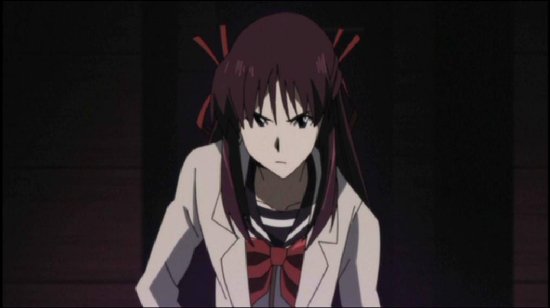
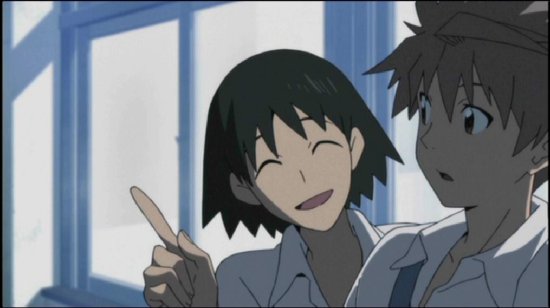
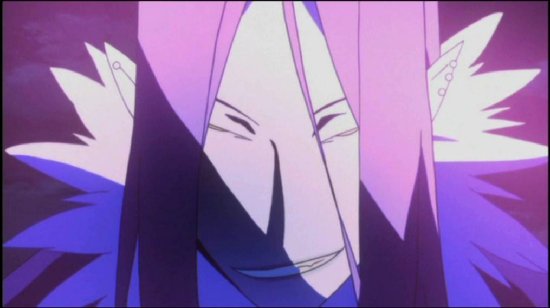
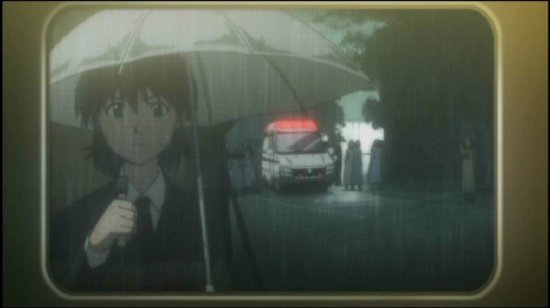

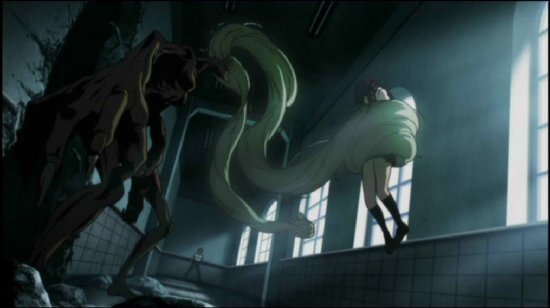

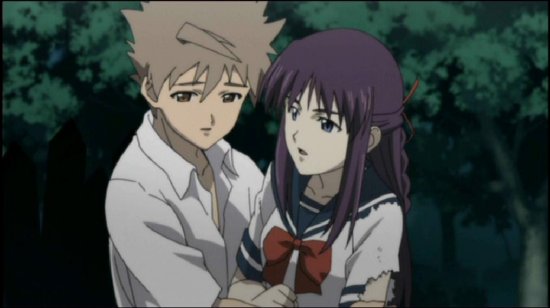
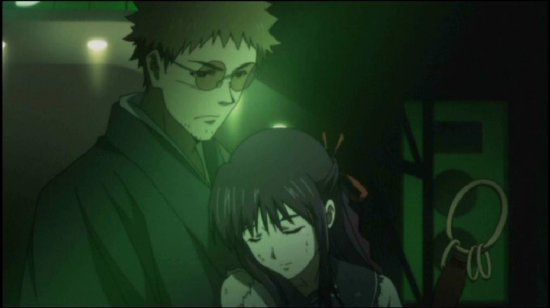
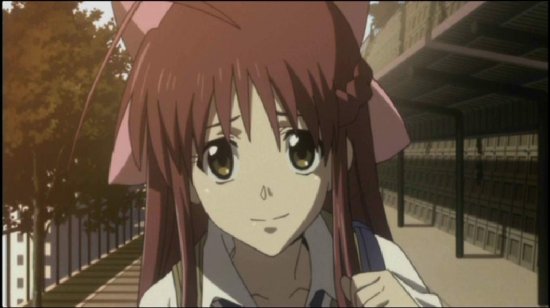
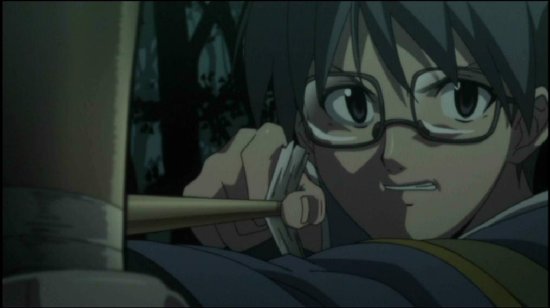
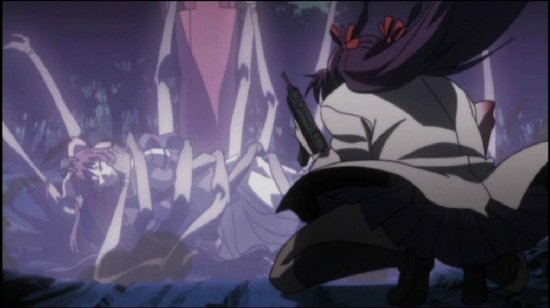
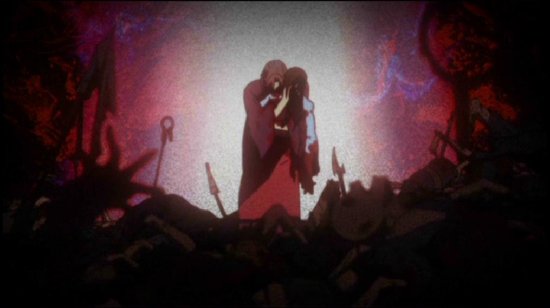
Your Opinions and Comments
Be the first to post a comment!